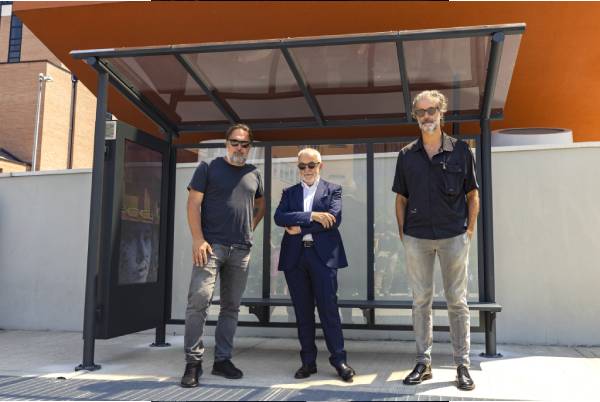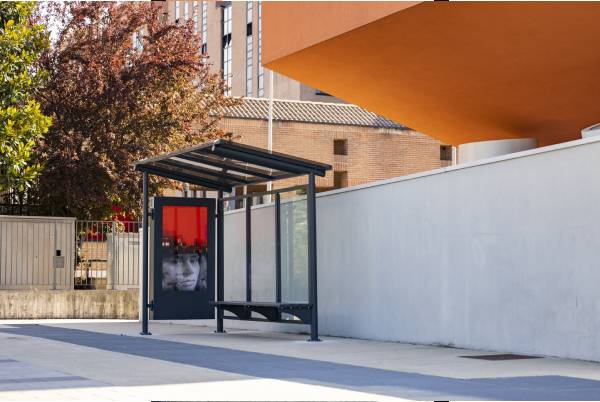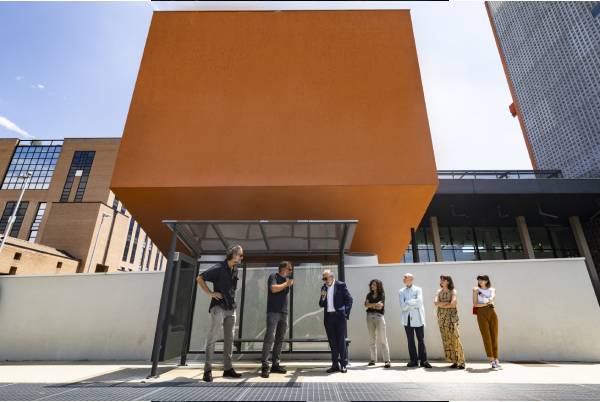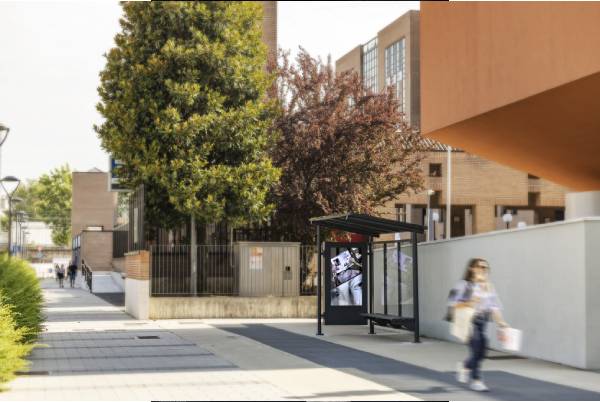
MASBEDO - Time Without End
MASBEDO, Time Without End, 2021
Final Project
Curated by 2nd year Master’s Degree students in Art, valorisation, and market
IULM University
Time Without End is a site-specific installation by the artistic duo MASBEDO (Nicolò Massazza and Iacopo Bedogni). It was conceived for the project “Word of the Year”, an initiative by IULM University that in 2021 focused on the word “Waiting”.
“Waiting” is something that we all had to deal with during the pandemic; a dramatic condition that brought up our tendency to rush through our lives. The artists visualized the concept in the image of someone waiting for public transport while absently staring at the phone.
Hence, Time Without End: a bus stop shelter which incorporates a vertical monitor. Its shape resembles the bus shelters we are familiar with. However, the monitor does not contain any advertising. Rather, it broadcasts the artists’ montage: a selection of cinematic images, updated and repurposed in a different way every month, that gets distorted, transformed, and altogether post-produced. The artists’ imagery is inhabited by Toshirō Mifune’s close-up in Drunken Angel (1948), alongside with Gene Tierney’s reading the titular novel Time Without End in Leave Her To Heaven (1945). Similarly, Michelangelo Antonioni’s scenes dialogue with Ingmar Bergman’s ones; Sam Mendes’ American Beauty (1999) meets Mario Baffico’s No Man’s Land (1939).
By not being in any conventional art space, this public video-sculpture services a wide audience to approach contemporary art and allows passers-by to participate in the collective idea of ‘Waiting’; whilst it unsettles them by not serving as an actual bus stop.
In A User’s Guide to Détournement (1956), Guy Debord writes:
Any elements, no matter where they are taken from, can be used to make new combinations. […] Anything can be used. It goes without saying that one is not limited to correcting a work or to integrating diverse fragments of out-of-date works into a new one; one can also alter the meaning of those fragments in any appropriate way, leaving the imbeciles to their slavish reference to “citations.”
What happens when iconic old movies frames are relocated from their original film strips to a digital and more intimate device like our phone? And what if they were also displaced from theatre screens to a public and commercial display? Time Without End invites us to dwell on the history of technologies that determine our relation to images and how we perceive them.
After five years of researching both video and cinema – e.g., Videomobile (2018) and Resto (2021) – MASBEDO challenges again the methods of exhibiting video art and gives birth to a public video sculpture that underlines the tight bond between the dispositive and its storytelling. Their practice does not only focus on editing images, but it considers the setup in tandem.
Time Without End: a nonsense open-air waiting room. An anthology of metacinema. An insecure dispositive. A waterfall of distorted and unrecognizable images.
MASBEDO
The artistic duo known as MASBEDO is formed by Nicolò Massazza (Milan, 1973) and Iacopo Bedogni (Sarzana, 1970). Collaborating since 1999, they have combined the languages of video with the visual arts, performance and installation practices, as well as choreography, literature and music. Their research results in works that are intimate, anthropological, and socio-political in nature. Over the last five years their practice has focused on a close dialogue with the world of cinema and investigated the deepest aspects of humanity.
MASBEDO has exhibited in major Italian and international cultural institutions. The artists took part in the Venice Biennale in 2009, Art Basel in 2011 and Manifesta 12 in 2018. Their works are part of important public and private collections. Among them: Castello di Rivoli Museo d'Arte Contemporanea, Turin; MACRO, Rome; DA2 Domus Artium 2002, Salamanca; Centro Atlantico de Arte Moderno CAAM, Las Palmas; CAIRN Centre d'art, Digne-les-Bains; Tel Aviv Museum of Art.



